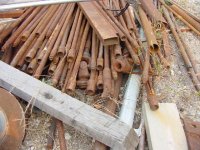MarkV
Super Member
- Joined
- Apr 7, 2000
- Messages
- 5,698
- Location
- Cedartown, Ga and N. Ga mountains
- Tractor
- 1998 Kubota B21, 2005 Kubota L39
Thought you Build-it-yourself people might have some thoughts on this idea. Yesterday there was a crew installing an in ground irrigation system at the house across the street. They used a Case trenching unit to cut trenches for the PVC pipe going in the ground. (this is new construction with out grass) When it came time to go under the drive, they hooked up two 10’ rods to a PTO take off on the front of the trencher. I could not see what the bit was. With the PTO turning the trencher provided forward movement pushing the rods through the ground. The drilling rod was flexible enough to allow a helper to keep a foot on it at the entry area directing the bore in a horizontal direction. I would guess this is the reason for a longer section of rod than needed for the width of the drive.
Besides the obvious use for water or conduit pipe under paved areas, I also thought this could be handy to clear clogged culvert pipes.
Although I have absolutely no need for such a thing, it got me thinking that this could be done with the PTO on a tractor. I was thinking that the universal joints on a PTO shaft would allow one to start at a more horizontal angle if a bracket could be made to contain the movement of the PTO shaft. Any thoughts on what would be the proper material for the drill rod and extensions? How about a bit? What do you all think?
MarkV
Besides the obvious use for water or conduit pipe under paved areas, I also thought this could be handy to clear clogged culvert pipes.
Although I have absolutely no need for such a thing, it got me thinking that this could be done with the PTO on a tractor. I was thinking that the universal joints on a PTO shaft would allow one to start at a more horizontal angle if a bracket could be made to contain the movement of the PTO shaft. Any thoughts on what would be the proper material for the drill rod and extensions? How about a bit? What do you all think?
MarkV

